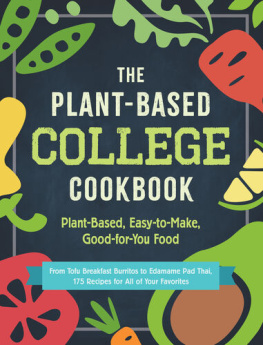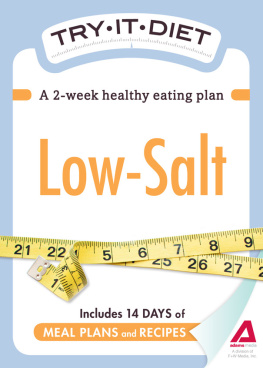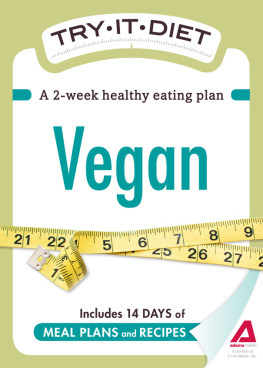Try-It Diet
DASH Diet
A two-week healthy eating plan
Adams Media, an imprint of Simon & Schuster, Inc.
Avon, Massachusetts
Contents
Introduction
The Try-It Diet: DASH Diet is intended to make life on a low-sodium diet easy and pleasurable. For those new to the diet, DASH is an acronym for Dietary Approaches to Stop Hypertension. The DASH diet is a healthy, balanced eating plan low in sodium and rich in fruits, vegetables, whole grains, and low-fat dairy products. Meats, sweets, and nuts are all permitted, although added sugars and fats should be eaten in moderation. A low-sodium DASH diet is often prescribed for those with serious medical conditions and has been shown to aid the body in healing by lowering blood pressure, reducing cholesterol, and promoting heart health and wellness in general. As with many sensible eating plans, it has the added bonus of promoting healthy weight loss and weight maintenance, and may also aid in the prevention of cancer, osteoporosis, and diabetes.
In short, the DASH diet has the potential for helping millions of people live longer, healthier lives. On the DASH diet, you will be enjoying many of the same foods youve always eaten: fresh fruits and vegetables, low-fat dairy products, whole grains, beans, meats, even desserts. You will not feel deprived! But you will need to adapt. Salt-free living isnt easy, but its worth it because youre worth it! Freeing yourself from the burden of bad health is a challenge to be taken to heart (pun intended). The first step to starting the DASH diet is simple: Stop using salt. From there youll need to stock a low-sodium pantry, seeking out products specifically created for a salt-free, low-sodium audience.
It helps to purchase a small food-counts book until youre familiar with the sodium content of most common foods. You may want to keep it in your purse or pocket and consult it while shopping or dining out. The good news is you can either buy or make everything you will need to live normally on the DASH diet. And as a low-sodium diet becomes more mainstream, companies are increasingly answering demand by expanding product lines, making salt-free cooking even easier and more convenient. What distinguishes the DASH diet from just suggesting eating healthful foods is it offers an optimal amount of the types of foods to eat. Without knowing these amounts, it is easy to eat in excess.
If you eat excessive amounts of any food, it will get stored as fat and contribute to obesity, which is unhealthy no matter what food contributed to it. The DASH diet suggests the following amounts:
- Whole Grains: 68 daily servings
- Lean Meats or Fish: 6 daily servings or less
- Vegetables: 45 daily servings
- Fruits: 45 daily servings
- Lean Dairy Products: 23 daily servings
- Fats and Oils: 23 daily servings or less
- Nuts, Seeds, or Legumes: 45 weekly servings
- Sweets and Added Sugars: 5 weekly servings or less
These servings vary based on your caloric needs, but the proportions should stay relatively the same. For example, if you are very active and burn about 3,000 calories per day, you may want to increase whole grains to 912 servings, fruits and vegetables to 68 servings each, and so on. Similarly, if you are highly inactive, you may want to reduce these amounts somewhat. However, in general, rather than reducing your intake you should if possible increase your activity and how many calories you use, as that has many other health benefits. With sodium, the DASH diet actually has two different types of recommendations.
The regular DASH diet suggests limiting sodium intake to 2,300 mg daily. If you eat the foods suggested in the DASH diet, you should be able to meet this goal without too much difficulty, but to be sure you can simply add up the sodium content of the various foods you eat to determine your daily total. The alternative suggestion is for people at especially high risk, including middle-aged to elderly adults, African Americans, and those who already have high blood pressure. For these higher-risk groups, the recommended sodium intake is not to exceed 1,500 mg daily. Wherever you live, seek out stores and scour for products that meet low-sodium criteria (140 mg or less per serving). Engage with the world around you, visiting local farms and farmers markets, to buy the freshest and best produce, preferably organic whenever possible.
New dishes will inevitably grow out of each season, and by incorporating the freshest ingredients, youll be giving your body the best you possibly can. Outside of diet alone, explore every avenue at your disposal for healthy living. Join a gym, take an exercise class, or just go outside and take a walk, daily if possible. Look forward to spending time taking care of yourself. A low-sodium diet is something you must commit to. You cant slack off and expect to make inroads.
It can be hard, but dont give up. Your body will thank you! On those days when you feel as though youre simply treading water, remind yourself: youre in the pool! Those above you on the bleachers can see your progress, even when you cant. You may struggle with fatigue, but with daily practice youre building endurance, and ultimately, success. As with any major health change, consult a doctor before starting a new diet. Keep in mind that this book is just a trial, and there is more detailed info out there. [PRODUCTION: Everything in these two meal plans, except for the highlighted items, should be linked to the recipe.]
Weekly Meal Plans
Week 1
Sunday
BreakfastLunchSnack2 cups air-popped popcorn and 1 cups fruit saladDinner
Monday
BreakfastLunchSnack1 medium banana and 1 slice whole-grain toastDinner
Tuesday
BreakfastLunchSnack1 large apple and 2 ounces low-fat cheeseDinner
Wednesday
BreakfastLunchSnackGranola bar and 1 cups mixed berriesDinner
Thursday
BreakfastLunchSnack2 ounces low-fat cheese and 1 large orangeDinner
Friday
BreakfastLunchSnackDinner
Saturday
BreakfastLunchSnack1 cup strawberries with 4 ounces fat-free plain yogurtDinnerWeek 2
Sunday
BreakfastLunchSnack1 cup cooked carrots with 1 cup cooked brown riceDinner
Monday
BreakfastLunchSnackWhole-grain crackers with 2 ounces low-fat cheese and 1 sliced pearDinner
Tuesday
BreakfastLunchSnacksmall cantaloupe and cup blueberriesDinner
Wednesday
BreakfastLunchSnack2 cups mixed fruit saladDinner
Thursday
BreakfastLunchSnack2 slices whole-grain toast and 4 ounces low-fat cottage cheese




















